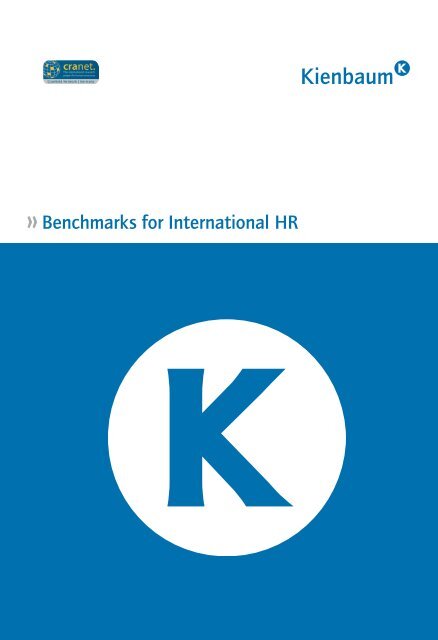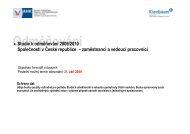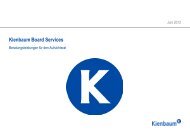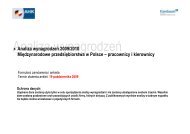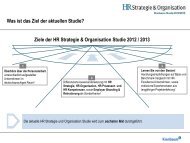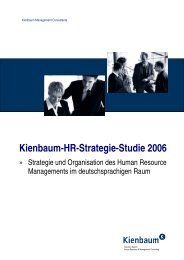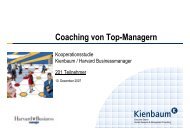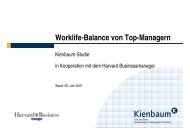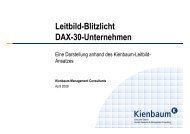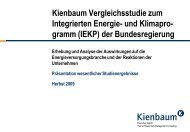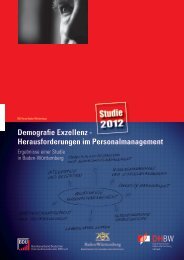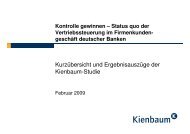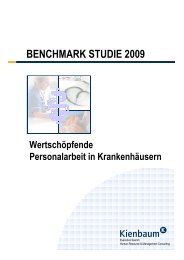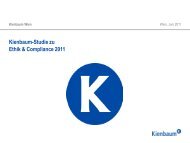Benchmarks for International HR - Kienbaum
Benchmarks for International HR - Kienbaum
Benchmarks for International HR - Kienbaum
Create successful ePaper yourself
Turn your PDF publications into a flip-book with our unique Google optimized e-Paper software.
» <strong>Benchmarks</strong> <strong>for</strong> <strong>International</strong> <strong>HR</strong>
2<br />
The data <strong>for</strong> the present report is derived from the seventh survey of the<br />
Cranfi eld Project on <strong>International</strong> Human Resource Management (Cranet).<br />
Launched in 1989, the “Cranfield Network on <strong>International</strong> Strategic Human<br />
Resource Management” is aimed at comparing international business practices<br />
in the field of human resource management.<br />
Today, the network is a collaboration between 41 universities across the globe,<br />
each of them responsible <strong>for</strong> conducting the surveys in their particular country.<br />
The Justus-Liebig-University in Giessen represents Germany within the project.<br />
Due to our partnership with the University of Giessen, <strong>Kienbaum</strong> Management<br />
Consultants had the chance to participate in the project.<br />
The seventh survey period took place in 2009, <strong>for</strong> some specific countries in 2010.<br />
In total, 6029 organisations from 30 countries have participated.<br />
The report and the remainder of the data from the Cranet Project can be made<br />
available on request.<br />
<strong>Kienbaum</strong> Management Consultants GmbH, 2011<br />
Paul M. Kötter
Content<br />
1. Introduction ...........................................................................................<br />
2. Basic Work<strong>for</strong>ce Data ......................................................................... 6<br />
2.1 <strong>HR</strong> Ratio ............................................................................................... 8<br />
2.2 Labour Costs ....................................................................................... 9<br />
2.3 Turnover ................................................................................................ 10<br />
2.4 Age Structure ....................................................................................... 11<br />
2.5 Absenteeism ........................................................................................ 12<br />
2.6 Education Level & Management of Industrial Relations ....... 14<br />
3. <strong>HR</strong> Core Processes<br />
16<br />
3.1 Source & Select ................................................................................... 18<br />
3.2 Per<strong>for</strong>mance Management ............................................................. 20<br />
3.3 Compensation & Benefits ................................................................ 21<br />
3.4 Talent Management .......................................................................... 23<br />
3.5 Learning Management ..................................................................... 24<br />
4. <strong>HR</strong> Strategy & Organisation ........................................................... 26<br />
4.1 <strong>HR</strong> Strategy .......................................................................................... 28<br />
4.2 <strong>HR</strong> Controlling .................................................................................... 30<br />
<strong>Kienbaum</strong> – Your Competent Partner ................................................. 32<br />
Locations .................................................................................................... 34<br />
5
Introduction<br />
In this report, <strong>Kienbaum</strong> presents a selection of essential in<strong>for</strong>mation<br />
about current international <strong>HR</strong>M practices and processes, offering a<br />
short and simple overview of major topics and selected data that is<br />
of relevance <strong>for</strong> <strong>HR</strong> practitioners. To make accessing and using this<br />
key data easier <strong>for</strong> the reader, we have chosen the <strong>for</strong>m of a booklet<br />
<strong>for</strong> our findings.<br />
To summarize the complex data sourced from 30 countries<br />
world-wide, we have decided to define 6 regional clusters:<br />
Cluster<br />
Germanic Europe<br />
Nordic Europe<br />
Eastern Europe<br />
Latin Europe<br />
Anglo<br />
Confucian Asia<br />
Germany<br />
Austria<br />
Switzerland<br />
Denmark<br />
Finland<br />
Sweden<br />
Iceland<br />
Norway<br />
Countries<br />
Bulgaria<br />
Czech Republic<br />
Estonia<br />
Greece<br />
Hungary<br />
Lithuania<br />
Slovakia<br />
Slovenia<br />
Russia<br />
Serbia<br />
Belgium<br />
Turkish Cypriotic Community<br />
Cyprus<br />
France<br />
Israel<br />
United Kingdom<br />
USA<br />
Australia<br />
South Africa<br />
Japan<br />
Philippines<br />
Taiwan<br />
∑<br />
722<br />
1016<br />
1417<br />
661<br />
1572<br />
651<br />
Anglo, Confucian Asia, Eastern Europe, Germanic Europe, Latin<br />
Europe, and Nordic Europe.* However, it was necessary to break<br />
down some of the data to the level of individual countries and<br />
industries to illustrate a number of major differences in more detail.<br />
The figure below presents the 6 clusters and the corresponding<br />
countries.<br />
* These clusters are based on the GLOBE<br />
study (Global Leadership and Organizational<br />
Behaviour Effectiveness Research Program),<br />
which was aimed at finding support <strong>for</strong><br />
hypothesized differences in leadership<br />
between cultures by comparing data from<br />
62 countries. Compared to relying on<br />
geographical regions alone, applying these<br />
clusters promises a more intelligible and<br />
empirically sound explanation of potential<br />
differences in the <strong>HR</strong> practices presented<br />
here.<br />
5
Basic Work<strong>for</strong>ce Data<br />
2.1 <strong>HR</strong> Ratio<br />
2.2 Labour Costs<br />
2.3 Turnover<br />
2.4 Age Structure<br />
2.5 Absenteeism<br />
2.6 Education Level & Management of Industrial Relations
8<br />
2.1 <strong>HR</strong> Ratio<br />
The <strong>HR</strong> ratio as well as the <strong>HR</strong> ratio per 100 employees both<br />
show a wide spread of data in the participating countries. One<br />
human resources manager in the Czech Republic, <strong>for</strong> instance,<br />
is responsible <strong>for</strong> 125 employees, whereas one human resources<br />
manager on the Philippines is in charge of only 45 employees.<br />
In turn, the <strong>HR</strong> ratio per 100 employees shows that 2.2 human<br />
resources managers on the Philippines, but only 0.8 human<br />
resources managers in the Czech Republic are in charge of<br />
100 employees.<br />
<strong>HR</strong> Ratio*<br />
Czech Republic<br />
Lithuania<br />
Slovenia<br />
Sweden<br />
Finland<br />
Iceland<br />
Australia<br />
Bulgaria<br />
Denmark<br />
Israel<br />
Japan<br />
Serbia<br />
Taiwan<br />
Austria<br />
Norway<br />
France<br />
Belgium<br />
Cyprus<br />
Estonia<br />
Germany<br />
Greece<br />
Hungary<br />
Russia<br />
Slovakia<br />
Switzerland<br />
USA<br />
United Kingdom<br />
Turkish Cypriot Community<br />
South Africa<br />
Philippines<br />
45<br />
125<br />
125<br />
125<br />
125<br />
111<br />
111<br />
100<br />
100<br />
100<br />
100<br />
100<br />
100<br />
100<br />
91<br />
91<br />
83<br />
77<br />
77<br />
77<br />
77<br />
77<br />
77<br />
77<br />
77<br />
77<br />
77<br />
77<br />
71<br />
67<br />
<strong>HR</strong> Ratio per 100 employees*<br />
Philippines<br />
South Africa<br />
Turkish Cypriot Community<br />
United Kingdom<br />
USA<br />
Switzerland<br />
Slovakia<br />
Russia<br />
Hungary<br />
Greece<br />
Germany<br />
Estonia<br />
Cyprus<br />
Belgium<br />
France<br />
Norway<br />
Austria<br />
Taiwan<br />
Serbia<br />
Japan<br />
Israel<br />
Denmark<br />
Bulgaria<br />
Australia<br />
Iceland<br />
Finland<br />
Sweden<br />
Slovenia<br />
Lithuania<br />
Czech Republic<br />
1.5<br />
1.4<br />
1.3<br />
1.3<br />
1.3<br />
1.3<br />
1.3<br />
1.3<br />
1.3<br />
1.3<br />
1.3<br />
1.3<br />
1.3<br />
1.2<br />
1.1<br />
1.1<br />
1.0<br />
1.0<br />
1.0<br />
1.0<br />
1.0<br />
1.0<br />
1.0<br />
0.9<br />
0.9<br />
0.8<br />
0.8<br />
0.8<br />
0.8<br />
* Analysis of the median. Practical meaning of median: 50 %<br />
of all surveyed companies of the specific country present a<br />
<strong>HR</strong> Ratio/<strong>HR</strong> Ratio per 100 employees smaller than the value<br />
pointed by the median, 50 % present a higher value pointed<br />
by the median.<br />
2.2
Nordic Europe<br />
Anglo<br />
Latin Europe<br />
Germanic Europe<br />
Eastern Europe<br />
Confucian Asia<br />
Banking; finance; insurance;<br />
business services<br />
Other services<br />
Personal, domestic,<br />
recreational services<br />
Transport and communication<br />
Retail and distribution;<br />
hotels; catering; repairs<br />
Building and civil engineering<br />
2.2 Labour Costs<br />
Labour costs as part of operating costs by cluster (in %)<br />
Labour costs related to operating costs<br />
by industry sector (in %)<br />
Education<br />
Social services<br />
Health services<br />
Public administration<br />
Other<br />
Agriculture, hunting, <strong>for</strong>estry, fishing<br />
Metal manufacturing; mechanical,<br />
electrical and instrument engineering<br />
Energy and water<br />
Other manufacturing<br />
Chemical products: extraction and<br />
processing of non-energy minerals<br />
26<br />
41<br />
39<br />
36<br />
35<br />
31<br />
31<br />
31<br />
27<br />
24<br />
37<br />
44<br />
44<br />
53<br />
50<br />
49<br />
48<br />
56<br />
55<br />
66<br />
65<br />
62<br />
With 55 % labour costs as part of operating costs in Nordic<br />
Europe, nearly 30 percentage points separate this region from<br />
Confucian Asia with 26 %. With the exception of Eastern Europe<br />
(37 %), the other clusters in the middle of the range show almost<br />
the same difference with results of over 40 %.<br />
At 66 %, the educational sector shows the highest labour costs.<br />
Comparing this result with the chemical products sector at the last<br />
spot, the difference is 42 percentage points (24 %). The educational<br />
sector is followed by social services (65 %) and health services<br />
(62 %). The 8 highest industry sectors report labour costs of over<br />
40 %, whereas the remaining sectors show lower costs, ranging<br />
around 30 %.<br />
9
10<br />
2.3 Turnover<br />
Turnover by cluster (in %)<br />
Anglo<br />
Eastern Europe<br />
Nordic Europe<br />
Latin Europe<br />
Germanic Europe<br />
Turnover by country (in %)<br />
Lithuania<br />
Australia<br />
Russia<br />
Czech Republic<br />
Iceland<br />
Israel<br />
Denmark<br />
Slovakia<br />
United Kingdom<br />
South Africa<br />
Philippines<br />
Estonia<br />
Bulgaria<br />
USA<br />
Hungary<br />
Taiwan<br />
France<br />
Switzerland<br />
Turkish Cypriot Community<br />
Cyprus<br />
Austria<br />
Belgium<br />
Sweden<br />
Slovenia<br />
Serbia<br />
Finland<br />
Greece<br />
Norway<br />
Germany<br />
Turnover by sector of industry (in %)<br />
Retail and distribution;<br />
hotels; catering; repairs<br />
Personal, domestic,<br />
recreational services<br />
Other services<br />
Building and civil engineering<br />
Other<br />
Banking; finance; insurance;<br />
business services<br />
Transport and communication<br />
Other manufacturing<br />
Social services<br />
Metal manufacturing; mechanical,<br />
electrical and instrument engineering<br />
Health services<br />
Education<br />
Chemical products: extraction and<br />
processing of non-energy minerals<br />
Agriculture, hunting, <strong>for</strong>estry, fishing<br />
Public administration<br />
Energy and water<br />
7<br />
15<br />
14<br />
14<br />
14<br />
13<br />
13<br />
13<br />
12<br />
12<br />
12<br />
12<br />
11<br />
11<br />
11<br />
11<br />
10<br />
9<br />
8<br />
8<br />
8<br />
7<br />
7<br />
7<br />
6<br />
6<br />
11<br />
11<br />
11<br />
10<br />
10<br />
9<br />
8<br />
7<br />
11<br />
11<br />
10<br />
17<br />
17<br />
17<br />
16<br />
15<br />
14<br />
13<br />
13<br />
13<br />
13<br />
21<br />
20<br />
21<br />
The Anglo region shows the highest turnover rate with 13 %<br />
of employees switching jobs per year – six percentage points<br />
more than Germanic Europe, which reports the lowest turnover.<br />
On average, only 7 % of German, Austrian and Swiss employees<br />
leave their employers per year. Nordic Europe – falling in the<br />
middle of the range – also shows a turnover 4 percentage points<br />
higher than Germanic Europe.<br />
Considering the turnover rates by country, greater differences<br />
can be found: Lithuania shows the by far highest turnover, with<br />
21 % employees leaving their company per year on average.<br />
This is a difference of 15 percentage points to Germany (6 %),<br />
mirroring the results by cluster. For Australia, the results reveal<br />
the second highest turnover rate of 20 %. This is also consistent<br />
with the Anglo cluster holding the first rank within the general<br />
comparison by cluster.<br />
The turnover data by sector of industry reveals similar contrasts.<br />
The sectors of retail and distribution/hotels/catering/repairs<br />
represents the top rank (21 %) with a turnover nearly 14 percentage<br />
points higher than in the energy and water sector (7 %).<br />
The following sectors, such as personal, domestic, recreational<br />
services, and other services, show turnover rates at 17 %<br />
and 16 % respectively. Public administration and in particular,<br />
the energy and water sector report the lowest turnover (8 %<br />
and 7 % respectively).
2.4 Age Structure<br />
Regarding the age structure within and between the clusters,<br />
the most conspicuous findings can be found in Confucian Asia:<br />
This is the only cluster with more than 40 % of the employees<br />
under 25 years of age. Germanic Europe, with 33 % of its<br />
employees under 25, and the remaining clusters follow at a<br />
considerable distance, all showing similar proportions of young<br />
workers. On the other hand, Confucian Asia reports a rather small<br />
proportion of middle-aged employees between 25 and 45 (28 %).<br />
Still, the clusters do not differ significantly regarding the proportions<br />
of older workers: All of them report a rate of around 30 %.<br />
Confucian Asia 41 28 31<br />
Germanic Europe 33 34 33<br />
Latin Europe 31 35 34<br />
Nordic Eurpe 31 35 34<br />
Anglo 31 34 35<br />
Eastern Europe 31 35 34<br />
Employees under 25 years Employees over 25 years and under 45 years Employees over 45 year<br />
Israel<br />
Serbia<br />
Cyprus<br />
United Kingdom<br />
Bulgaria<br />
Age structure by cluster (in %)<br />
Oldest work<strong>for</strong>ces by country –<br />
employees over 45 years of age (in %)<br />
Youngest work<strong>for</strong>ces by country –<br />
employees under 25 years of age (in %)<br />
Estonia<br />
Australia<br />
Switzerland<br />
Slovakia<br />
Austria<br />
36<br />
36<br />
35<br />
35<br />
35<br />
35<br />
34<br />
34<br />
33<br />
33<br />
Israel and Serbia report the oldest work<strong>for</strong>ces in the sample, with<br />
36 % of the employees in these countries over 45 years of age.<br />
The other 3 countries among the top 5 oldest work<strong>for</strong>ces show<br />
almost the same results. All of these report that 35 % of their<br />
employees are over 45 years of age.<br />
By contrast, the youngest work<strong>for</strong>ces were found in Estonia,<br />
with 35 % employees under 25 years of age. This is followed<br />
by Australia and Switzerland, who both show results of 34 %<br />
employees under 25, while Slovakia and Austria report 33 %<br />
employees under 25 years of age.<br />
11
Germanic Europe<br />
Latin Europe<br />
Nordic Europe<br />
Eastern Europe<br />
Anglo<br />
12<br />
2.5 Absenteeism<br />
Absenteeism by cluster*<br />
(days per employee per year on average)<br />
Social services<br />
Other services<br />
Health services<br />
Retail and distribution;<br />
hotels; catering; repairs<br />
Absenteeism by sector – top 5<br />
(days per employee per year on average)<br />
Public administration<br />
Lithuania<br />
Cyprus<br />
Czech Republic<br />
Finland<br />
Sweden<br />
* Excluding Confucian Asia<br />
Absenteeism by country – top 5<br />
(days per employee per year on average)<br />
7<br />
14<br />
13<br />
12<br />
10<br />
10<br />
10<br />
11<br />
14<br />
13<br />
13<br />
12<br />
12<br />
19<br />
18<br />
The results on absenteeism show that the average employee in<br />
Germanic Europe is absent <strong>for</strong> 11 days per year – almost one and<br />
a half times the amount of days employees in the Anglo region<br />
are absent (7 days per year on average). The absenteeism rate per<br />
sector seems to be fairly equally distributed, except <strong>for</strong> the sector<br />
of social services, which shows 14 days per year. Looking at some<br />
countries in more detail, Lithuania reports the highest degree of<br />
absenteeism, with 19 days per year, reminiscent of the results on<br />
turnover.
14<br />
2.6 Education Level & Management<br />
of Industrial Relations<br />
Concerning the level of education, Confucian Asia was found<br />
to have the highest proportion of employees with a higher<br />
education/university degree (49 %). This represents a significantly<br />
more educated work<strong>for</strong>ce than in Eastern Europe (35 %), Nordic<br />
Europe (32 %) and, in particular, Germanic Europe. At 26 %,<br />
the latter cluster reports the lowest ratio of highly educated<br />
workers of all regions.<br />
Level of higher education/university qualification<br />
in work<strong>for</strong>ce by cluster (in %)<br />
Confucian Asia<br />
Anglo<br />
Latin Europe<br />
Eastern Europe<br />
Nordic Europe<br />
Germanic Europe<br />
Anglo 70 20 10<br />
Eastern Europe 65 24 11<br />
Germanic Europe 64 27 9<br />
Confucian Asia 59 18 23<br />
Latin Europe 55 20 25<br />
Nordic Europe 8 38 54<br />
0 % - 25 % 26 % - 75 % 76 % - 100 %<br />
35<br />
32<br />
The respondents from the USA, Australia, South Africa, and the<br />
UK (representing the Anglo cluster) show the lowest proportion of<br />
trade union members in their work<strong>for</strong>ces. Almost three quarters<br />
report a ratio of less than 26 %. The other clusters show similar<br />
proportions, although a quarter of the respondents from Confucian<br />
Asia and Latin Europe report that their work<strong>for</strong>ce contain at least<br />
76 % trade union members. However, the Nordic European<br />
respondents report the most unionised work<strong>for</strong>ce. More than half<br />
of them report that at least 76 % of their employees are trade<br />
union members.<br />
26<br />
Proportion of trade union members in the work<strong>for</strong>ce<br />
by cluster (in %)<br />
43<br />
49<br />
47
Respondents from Nordic Europe report the greatest extent<br />
of influence of trade unions within their organisations.<br />
35 % describe the trade union’s influence as great or very great<br />
respectively. This result differs by more than 30 percentage points<br />
from the data <strong>for</strong> Confucian Asia, where only 5 % of respondents<br />
report a great influence of trade unions. Thus, 67 % in Confucian<br />
Asia do not notice any significant influence, followed by respondents<br />
from the Anglo region (50 %) and Eastern Europe (45 %).<br />
Considering the results by sectors of industry, public administration<br />
as well as energy and water hold the top rank at about 35 % of<br />
respondents recording great influence – almost 25 percentage<br />
points higher than in sectors like personal, domestic, recreational<br />
services, engineering, or banking and finance.<br />
Extent of influence of trade unions within the organisation by cluster (in %)<br />
Nordic Europe 35 56 9<br />
Latin Europe 27 54 19<br />
Anglo 14 35 51<br />
Germanic Europe 14 53 33<br />
Eastern Europe 11 44 45<br />
Confucian Asia 5 28 67<br />
To a very great/great extent To a small/some extent Not at all<br />
Extent of influence of trade unions within the organisation by sector (in %)<br />
Public administration<br />
Energy and water<br />
Education<br />
Transport and communication<br />
Health services<br />
Social services<br />
Chemical products: extraction and<br />
processing of non-energy minerals<br />
Agriculture, hunting, <strong>for</strong>estry, fishing<br />
Other manufacturing<br />
Other services<br />
Metal manufacturing; mechanical,<br />
electrical and instrument engineering<br />
Other<br />
Retail and distribution;<br />
hotels; catering; repairs<br />
Personal, domestic,<br />
recreational services<br />
Building and civil engineering<br />
Banking; finance; insurance;<br />
business services<br />
35 50 15<br />
34 53 13<br />
26 44 30<br />
23 45 32<br />
23 51 26<br />
20 46 34<br />
18 64 18<br />
18 48 34<br />
17 52 31<br />
14 37 49<br />
14 51 35<br />
12 36 52<br />
10 39 51<br />
9 35 56<br />
9 43 48<br />
8 39 53<br />
To a very great/great extent To a small/some extent Not at all<br />
15
<strong>HR</strong> Core Processes<br />
3.1 Source & Select<br />
3.2 Per<strong>for</strong>mance Management<br />
3.3 Compensation & Benefits<br />
3.4 Talent Management<br />
3.5 Learning Management<br />
17
18<br />
3.1 Source & Select<br />
Recruitment methods (in %)<br />
Internally<br />
Advertisement<br />
Vacancy page on company website<br />
Word of mouth<br />
Recruitment agencies/consultancies<br />
Vacancies on commercial websites<br />
Unsolicited application/walk-ins<br />
Job centres/public recruitment agencies<br />
Direct from educational institution<br />
Other<br />
Recruitment methods by cluster – top 3 (in %)<br />
Anglo<br />
Anglo<br />
Confucian<br />
Asia<br />
Eastern<br />
Europe<br />
Germanic<br />
Europe<br />
Latin<br />
Europe<br />
Nordic<br />
Europe<br />
Internally<br />
14.7<br />
16.1<br />
15.1<br />
15.1<br />
14.6<br />
12.6<br />
Recruitment<br />
agencies/<br />
consultancies<br />
11.9<br />
Rank 1 Rank 2 Rank 3<br />
1<br />
8<br />
11<br />
11<br />
11<br />
10<br />
10<br />
9<br />
Advertisement<br />
13.5<br />
14.6<br />
13.8<br />
11.9<br />
14.4<br />
Word of<br />
mouth<br />
12.7<br />
12.4<br />
15<br />
14<br />
In general, the data concerning the recruitment methods show<br />
that 15 % of the participating organisations recruit internally.<br />
14 % use advertisements, whereas the other methods, such as<br />
word of mouth, websites, or unsolicited applications/walk-ins,<br />
show a similar degree of representation at about 10 %. The<br />
break-down by clusters mirrors this finding: Internal recruitment<br />
is again ranked first at about 15 % in nearly every cluster,<br />
followed mostly by advertisements, except <strong>for</strong> Nordic Europe.<br />
15.4 % of the respondents here report direct recruitment from<br />
educational institutions as the primary recruitment method,<br />
thus indicating a weaker internal labour market.<br />
Vacancy<br />
page on<br />
company<br />
website<br />
12.8<br />
13.6<br />
Vacancies on<br />
commercial<br />
job websites<br />
13.0<br />
Direct from<br />
educational<br />
institution<br />
15.4<br />
Unsolicited<br />
application/<br />
walk-ins<br />
Job centres/<br />
public<br />
recruitment<br />
agencies<br />
Other
Selection methods (in %)<br />
One-to-one interviews<br />
References<br />
Application <strong>for</strong>ms<br />
Interview panel<br />
Ability tests<br />
Technical tests<br />
Psychometric <strong>for</strong>ms<br />
Assessment centre<br />
Graphology<br />
Other<br />
1<br />
1<br />
Selection methods by cluster – top 3 (in %)<br />
Anglo<br />
Anglo<br />
Confucian<br />
Asia<br />
Eastern<br />
Europe<br />
Germanic<br />
Europe<br />
Latin<br />
Europe<br />
Nordic<br />
Europe<br />
One-to-one<br />
interviews<br />
15.6<br />
24.4<br />
23.2<br />
21.0<br />
20.8<br />
18.5<br />
References<br />
25.5<br />
24.0<br />
20.9<br />
18.1<br />
18.5<br />
Rank 1 Rank 2 Rank 3<br />
5<br />
9<br />
8<br />
Application<br />
<strong>for</strong>ms<br />
17.0<br />
20.9<br />
14.6<br />
13.9<br />
15.1<br />
29.6<br />
16<br />
15<br />
14<br />
One-to-one interviews are the most popular selection method<br />
(19 %) in the given sample, followed by references (16 %),<br />
application <strong>for</strong>ms (15 %), and interview panels (14 %). By contrast,<br />
the least popular method seems to be the use of assessment<br />
centres (5 %) or graphology (1 %). Certain differences can be<br />
made out in the regional clusters: Confucian Asia, Germanic,<br />
11<br />
Interview<br />
panel<br />
Psychometric<br />
tests<br />
19<br />
Assessment<br />
centres<br />
Ability tests<br />
19.1<br />
Technical<br />
tests<br />
Graphology<br />
and Latin Europe report one-to-one interviews as the most<br />
common selection method, while references are mentioned<br />
by respondents from the Anglo region and Eastern Europe.<br />
Only Nordic Europe records application <strong>for</strong>ms as the most<br />
frequently used method (29.6 %).<br />
Other<br />
19
20<br />
3.2 Per<strong>for</strong>mance Management<br />
Formal appraisal system <strong>for</strong> work<strong>for</strong>ce groups by cluster (in %)<br />
Anglo 38 38 14 10<br />
Confucian Asia 25 25 25 25<br />
Eastern Europe 26 26 25 23<br />
Germanic Europe 20 22 26 32<br />
Latin Europe 20 20 24 36<br />
Nordic Europe 29 28 26 17<br />
Management Professional/Technical Clerical Manual<br />
Concerning the existence of <strong>for</strong>mal appraisal systems in the<br />
work<strong>for</strong>ce, the results point at a rather even distribution across<br />
the clusters. The respondents from all clusters report the existence<br />
of a <strong>for</strong>mal appraisal system mostly <strong>for</strong> managers or professionals,<br />
while there seems to be a more narrow use of <strong>for</strong>mal appraisals<br />
<strong>for</strong> manual workers – with the exception <strong>for</strong> Latin Europe.<br />
The Anglo region in particular seems to have this focus on<br />
managers and professionals in its <strong>for</strong>mal appraisals (76 %).<br />
Regarding the purpose appraisal data are used <strong>for</strong>, some differences<br />
appear between the regions: while the respondents from Confucian<br />
Asia record a primary use in the context of pay decisions<br />
as well as in training and development activities, Nordic Europe<br />
and Latin Europe use this data more in the context of career<br />
decisions and work<strong>for</strong>ce planning. The Anglo region instead<br />
seems to focus primarily on using the data <strong>for</strong> pay decisions.<br />
Appraisal data used to in<strong>for</strong>m pay decisions<br />
by cluster (in %)<br />
Confucian Asia<br />
Anglo<br />
47<br />
Eastern Europe<br />
43<br />
Nordic Europe<br />
35<br />
Germanic Europe<br />
32<br />
Latin Europe 26<br />
Appraisal data used to in<strong>for</strong>m career moves<br />
by cluster (in %)<br />
Nordic Europe<br />
Confucian Asia<br />
Germanic Europe<br />
Eastern Europe<br />
70<br />
Latin Europe<br />
66<br />
Anglo 66<br />
Appraisal data used to in<strong>for</strong>m work<strong>for</strong>ce<br />
planning by cluster (in %)<br />
Latin Europe<br />
Germanic Europe<br />
Eastern Europe<br />
Nordic Europe<br />
Anglo<br />
Confucian Asia<br />
54<br />
53<br />
49<br />
47<br />
49<br />
84<br />
81<br />
78<br />
66<br />
62
3.3 Compensation & Benefits<br />
Bonus based on team<br />
goals/per<strong>for</strong>mance<br />
Bonus based on<br />
individual goals/<br />
per<strong>for</strong>mance<br />
Offerings in terms of compensation and benefits (in %)<br />
24<br />
17<br />
21<br />
8<br />
Per<strong>for</strong>mance-related pay<br />
Employee share schemes<br />
11<br />
6<br />
13<br />
Profit sharing<br />
Stock options<br />
Flexible benefits<br />
Offerings in terms of compensation and benefits by cluster – top 3 (in %)<br />
Anglo<br />
Anglo<br />
Confucian<br />
Asia<br />
Eastern<br />
Europe<br />
Germanic<br />
Europe<br />
Latin<br />
Europe<br />
Nordic<br />
Europe<br />
Employee<br />
share<br />
schemes<br />
18.3<br />
Profit<br />
sharing<br />
17.4<br />
Rank 1 Rank 2 Rank 3<br />
Stock<br />
options<br />
Flexible<br />
benefits<br />
16.6<br />
17.9<br />
In general, the most popular offering within compensation and<br />
benefits is a bonus based on individual goals and per<strong>for</strong>mance<br />
(24 %), followed by per<strong>for</strong>mance-related pay (21 %), and a bonus<br />
based on team goals/per<strong>for</strong>mance (17 %). By contrast, employee<br />
share schemes (8 %) and stock options (6 %) are the least common<br />
offerings. Regarding the regional clusters, no great differences can<br />
be identified in these results: 5 out of the 6 clusters report a bonus<br />
based on individual goals and per<strong>for</strong>mance as the most common<br />
offering within compensation and benefits, with all scores ranging<br />
above 22 %. However, Confucian Asia reports per<strong>for</strong>mancerelated<br />
pay as the most used offering at a level of 25.1 %.<br />
Per<strong>for</strong>mancerelated<br />
pay<br />
22.0<br />
25.1<br />
24.3<br />
21.6<br />
17.7<br />
Bonus based<br />
on individual<br />
goals/<br />
per<strong>for</strong>mance<br />
22.1<br />
24.9<br />
23.3<br />
24.2<br />
23.2<br />
Bonus based<br />
on team<br />
goals/<br />
per<strong>for</strong>mance<br />
16.0<br />
18.5<br />
17.0<br />
21.5<br />
21
22<br />
Offerings in excess of statutory requirements (in %)<br />
Maternity leave 17<br />
Pension schemes 15<br />
Paternity leave 14<br />
Parental leave 14<br />
Education/training break 14<br />
Private health care schemes 13<br />
Career break schemes 7<br />
Childcare allowances 3<br />
Workplace childcare 3<br />
Offerings in excess of statutory requirements by cluster – top 3 (in %)<br />
Anglo<br />
Anglo<br />
Confucian<br />
Asia<br />
Eastern<br />
Europe<br />
Germanic<br />
Europe<br />
Latin<br />
Europe<br />
Nordic<br />
Europe<br />
Workplace<br />
childcare<br />
Childcare<br />
allowances<br />
Rank 1 Rank 2 Rank 3<br />
Career break<br />
schemes<br />
Maternity<br />
leave<br />
18.6<br />
16.3<br />
17.7<br />
16.3<br />
15.0<br />
15.4<br />
For the whole sample, career break schemes (7 %), childcare<br />
allowances (3 %), and workplace childcare (3 %) are the<br />
least common offerings exceeding the statutory requirements.<br />
By contrast, maternity leave is used in 17 % of cases.<br />
Other offerings, such as pension schemes (15 %) or paternity<br />
or parental leave (14 % each), show similar results.<br />
Paternity<br />
leave<br />
15.8<br />
16.9<br />
Parental<br />
leave<br />
14.3<br />
15.2<br />
Pension<br />
schemes<br />
16.1<br />
17.1<br />
16.6<br />
17.4<br />
Education/<br />
training<br />
break<br />
18.0<br />
19.2<br />
14.9<br />
Private<br />
health care<br />
schemes<br />
19.6<br />
Concerning the clusters, significantly more differences can be<br />
found: While Eastern Europe and Germanic Europe predominantly<br />
seem to offer education/training breaks (18 % and 19.2 %<br />
respectively), respondents from the Anglo cluster report more<br />
use of maternity leave (18.6 %). At the same time, Confucian<br />
Asia seems to focus more on paternity leave (16.9 %), whereas<br />
respondents from Nordic Europe and Latin Europe primarily<br />
report pension schemes (17.4 %) and private health care schemes<br />
(19.6 %).
3.4 Talent Management<br />
Methods used <strong>for</strong> career development (in %)<br />
Project team work 10<br />
Special tasks/projects 9<br />
Cross-organisational/disciplinary tasks 9<br />
Coaching 8<br />
Mentoring 8<br />
Networking 8<br />
Experience schemes 7<br />
Succession plans 7<br />
Formal career plans 7<br />
Planned job rotation 7<br />
E-learning 6<br />
High flyer schemes 5<br />
Secondments to other organisations 5<br />
Development centres 4<br />
Other 0<br />
Methods used <strong>for</strong> career development by cluster – top 3 (in %)<br />
Anglo<br />
Anglo<br />
Confucian<br />
Asia<br />
Eastern<br />
Europe<br />
Germanic<br />
Europe<br />
Latin<br />
Europe<br />
Nordic<br />
Europe<br />
Special<br />
tasks/<br />
projects<br />
9.6<br />
8.5<br />
9.4<br />
8.9<br />
8.4<br />
9.5<br />
Cross-organisational/<br />
disciplinary<br />
tasks<br />
8.5<br />
8.2<br />
9.3<br />
9.8<br />
Project<br />
team work<br />
9.7<br />
9.6<br />
9.9<br />
9.1<br />
10.3<br />
Rank 1 Rank 2 Rank 3<br />
Networking<br />
Formal<br />
career plans<br />
Development<br />
centres<br />
Succession<br />
plans<br />
The methods used <strong>for</strong> career development show similar proportions<br />
and thus an even distribution <strong>for</strong> both the international sample as<br />
a whole and the specific regional clusters. In general, project team<br />
work (10 %), the assignment to special tasks/projects (9 %), and<br />
cross-organisational/disciplinary tasks (9 %) in particular are used<br />
mostly <strong>for</strong> career development. Correspondingly, all clusters mirror<br />
these results and report that project team work is most common,<br />
excluding Confucian Asia, whose respondents describe planned<br />
job rotation as the predominant method.<br />
Planned<br />
job rotation<br />
9.8<br />
High flyer<br />
schemes<br />
Experience<br />
schemes<br />
Secondments<br />
to other<br />
organisations<br />
Coaching Mentoring E-learning<br />
9.6<br />
Other<br />
23
24<br />
3.5 Learning Management<br />
Training of employee groups by cluster (days per year)*<br />
Anglo<br />
Eastern Europe<br />
Germanic Europe<br />
Latin Europe<br />
Nordic Europe<br />
Days per year training <strong>for</strong> manual<br />
Days per year training <strong>for</strong> clerical<br />
Days per year training <strong>for</strong> professional<br />
Days per year training <strong>for</strong> management<br />
* Excluding Confucian Asia<br />
2<br />
3<br />
4<br />
4<br />
4<br />
5<br />
5<br />
6<br />
6<br />
6<br />
6<br />
6<br />
6<br />
7<br />
7<br />
7<br />
8<br />
9<br />
10<br />
Above all, the differences in the days per year spent on training<br />
are the highest in Germany, Austria, and Switzerland. Professionals<br />
in these countries spend twice the number of days on training than<br />
managers (14 days and 7 days respectively). The other clusters<br />
show more evenly distributed results, although managers and<br />
professionals in particular again seem to receive the most intensive<br />
training.<br />
14
Systematic evaluation of training effectiveness by country (in %)<br />
Philippines<br />
Czech Republic<br />
United Kingdom<br />
Greece<br />
Australia<br />
Germany<br />
Cyprus<br />
Slovakia<br />
Taiwan<br />
South Africa<br />
France<br />
Turkish Cypriot Community<br />
Switzerland<br />
Slovenia<br />
Estonia<br />
Belgium<br />
Austria<br />
Bulgaria<br />
Hungary<br />
Russia<br />
Denmark<br />
USA<br />
Serbia<br />
Sweden<br />
Lithuania<br />
Israel<br />
Finland<br />
Norway<br />
Iceland<br />
Japan<br />
72<br />
70<br />
69<br />
66<br />
62<br />
60<br />
60<br />
60<br />
59<br />
57<br />
55<br />
55<br />
53<br />
52<br />
49<br />
47<br />
43<br />
42<br />
42<br />
41<br />
38<br />
36<br />
35<br />
31<br />
30<br />
29<br />
25<br />
22<br />
17<br />
78<br />
Few countries seem to invest ef<strong>for</strong>ts into a systematic evaluation<br />
of their training activities: At 78 %, the Philippines show the most<br />
intensive evaluation of such training. They are followed by the<br />
Czech Republic (72 %), the UK (70 %), and Greece, where 69 %<br />
of respondents report training evaluations. By contrast, only<br />
limited evaluations seem to take place in Norway (25 %), Iceland<br />
(22 %) and, above all, in Japan. In this region, only 17 % of the<br />
respondents report of a systematic evaluation of the effectiveness<br />
of their training.<br />
25
<strong>HR</strong> Strategy & Organisation<br />
4.1 <strong>HR</strong> Strategy<br />
4.2 <strong>HR</strong> Controlling
28<br />
4.1 <strong>HR</strong> Strategy<br />
Representation of <strong>HR</strong> on the board or its equivalent by cluster (in %)<br />
Latin Europe 79<br />
Nordic Europe 76<br />
Confucian Asia 67<br />
Anglo 66<br />
Eastern Europe 62<br />
Germanic Europe 54<br />
The representation of <strong>HR</strong> on the board or an equivalent is most<br />
common in Latin Europe. 79 % of the respondents from this region<br />
report that <strong>HR</strong> is represented on the board or its equivalent in<br />
their organisations. Latin Europe is followed by Nordic Europe at<br />
76 %. At a level of 54 %, Germanic Europe, however, shows the<br />
lowest level of representation of <strong>HR</strong> on the board level or an equal<br />
committee. Thus, 25 percentage points lie between the top and<br />
the bottom ranks.<br />
Recruitment source <strong>for</strong> the person responsible <strong>for</strong> <strong>HR</strong> by country (in %)<br />
Anglo 24 13 50 13<br />
Confucian Asia 38 39 16 7<br />
Eastern Europe 30 31 27 12<br />
Germanic Eurpe 26 22 39 13<br />
Latin Eurpe 31 21 43 5<br />
Nordic Europe 19 22 46 13<br />
From within the <strong>HR</strong> department From non-<strong>HR</strong> specialists within your organisation<br />
From <strong>HR</strong> specialists outside of your organisation From non-<strong>HR</strong> specialists outside of the organisation<br />
Four out of six clusters report that the most common recruitment<br />
source (39-50 %) <strong>for</strong> the person responsible <strong>for</strong> <strong>HR</strong> are <strong>HR</strong><br />
specialists from outside of the given organisation. Confucian Asia<br />
and Eastern Europe report more internal recruitment, focusing<br />
on their <strong>HR</strong> department or on non-<strong>HR</strong> specialists from within<br />
their organisation. However, non-<strong>HR</strong> specialists from outside the<br />
organisation represent the least used source <strong>for</strong> recruiting leading<br />
managers in <strong>HR</strong>.
Existence of diversity statements by cluster (in %)<br />
Anglo 79<br />
Nordic Europe 63<br />
Confucian Asia 50<br />
Latin Europe 50<br />
Eastern Europe 47<br />
Germanic Europe 37<br />
The existence of a diversity statement is most common in the<br />
Anglo region, where 79 % of the respondent organisations have<br />
<strong>for</strong>mulated such a statement. This cluster is followed by Nordic<br />
Europe (63 %) and – at some distance – Confucian Asia and Latin<br />
Europe (50 % respectively). Germanic Europe seems to have the<br />
fewest diversity statements: Only 37 % of the respondents from<br />
Germany, Austria, and Switzerland record the presence of an<br />
explicit statement within their company.<br />
Involvement of <strong>HR</strong> in the organisational strategy by cluster (in %)<br />
60<br />
25<br />
9<br />
6<br />
Nordic Europe<br />
48<br />
31<br />
9<br />
12<br />
48<br />
28<br />
16<br />
8<br />
46<br />
23<br />
20<br />
Anglo Latin Europe Eastern Europe Germanic Europe Confucian Asia<br />
From the outset Through subsequent consultation On implementation Not consulted<br />
Most of the organisations from all clusters report that their <strong>HR</strong><br />
is involved in the organisational strategy from the outset. Above<br />
all, 60 % of the respondents in Nordic Europe describe such a<br />
high degree involvement, followed at some distance by the Anglo<br />
region (48 %) and Latin Europe (48 %). In sum, these results point<br />
to a rather intensive involvement of <strong>HR</strong> in strategic organisational<br />
issues across all countries.<br />
11<br />
45<br />
28<br />
11<br />
16<br />
43<br />
33<br />
17<br />
7<br />
29
30<br />
4.2 <strong>HR</strong> Controlling<br />
Extent of the evaluation of the <strong>HR</strong> department by cluster (in %)<br />
43<br />
Anglo 50<br />
7<br />
40<br />
Confucian Asia 57<br />
3<br />
35<br />
Eastern Europe 45<br />
20<br />
17<br />
Germanic Europe 67<br />
16<br />
40<br />
Latin Europe 50<br />
10<br />
24<br />
Nordic Europe 64<br />
12<br />
To a great/very great extent To a small/some extent Not at all<br />
The results regarding the extent to which the <strong>HR</strong> department is<br />
evaluated present a rather heterogeneous picture: All clusters<br />
show that the <strong>HR</strong> department in the organisation is only evaluated<br />
to a small or limited extent. While around 40 % of the respondents<br />
in the Anglo, Confucian Asia, Eastern Europe and Latin Europe<br />
regions describe the extent of the evaluation of their <strong>HR</strong><br />
department as great or very great respectively, the majority of<br />
the participating organisations in Nordic Europe and Germanic<br />
Europe report only a smaller degree of a systematic evaluation.
Views of top management considered when evaluating<br />
the per<strong>for</strong>mance of the <strong>HR</strong> department by cluster (in %)<br />
Eastern Europe 35<br />
Anglo 34<br />
Confucian Asia 33<br />
Germanic Europe 32<br />
Latin Europe 31<br />
Nordic Europe 31<br />
Views of line management considered when evaluating<br />
the per<strong>for</strong>mance of the <strong>HR</strong> department by cluster (in %)<br />
Eastern Europe 29<br />
Nordic Europe 29<br />
Latin Europe 28<br />
Germanic Europe 26<br />
Anglo 26<br />
Confucian Asia 24<br />
Views of employees considered when evaluating<br />
the per<strong>for</strong>mance of the <strong>HR</strong> department by cluster (in %)<br />
Germanic Europe 20<br />
Nordic Europe 19<br />
Anglo 19<br />
Latin Europe 18<br />
Eastern Europe 18<br />
Confucian Asia 17<br />
Views of personnel/<strong>HR</strong> function itself considered when evalua-<br />
ting the per<strong>for</strong>mance of the <strong>HR</strong> department by cluster (in %)<br />
Confucian Asia 26<br />
Latin Europe 23<br />
Germanic Europe 22<br />
Anglo 22<br />
Nordic Europe 21<br />
Eastern Europe 18<br />
Asked about the views considered in the evaluation process of the<br />
<strong>HR</strong> department, the results reveal certain differences: Across all<br />
clusters, the views of the top management are considered most<br />
frequently (all over 30 %), followed by the views of line managers<br />
and those of the personnel/<strong>HR</strong> function itself (mostly over 20 %).<br />
The views of employees are considered least in all clusters (mostly<br />
under 20 %). Eastern Europe in particular seems to rely on the<br />
views of top management and line management while considering<br />
the views of employees or the personnel/<strong>HR</strong> function itself only<br />
to a very moderate degree.<br />
31
32<br />
<strong>Kienbaum</strong> – Your Competent Partner<br />
Executive Consultants (KEC)<br />
» Recruitment of<br />
» Supervisory board members<br />
» Advisory board members<br />
» Executive board members<br />
» Management board members<br />
» Executive positions<br />
» Specialists positions<br />
» Interim Management<br />
» Career Consulting<br />
» Management Audits<br />
» NewPlacement<br />
» Sectors of Industry<br />
» Automotive<br />
» Chemicals / Pharmaceuticals<br />
» Energy & Utilities<br />
» Financial Services & Real Estate<br />
» Locations domestic<br />
» Berlin<br />
» Dresden<br />
» Düsseldorf<br />
» Frankfurt<br />
» Freiburg<br />
» Gummersbach<br />
» Hamburg<br />
» Hanover<br />
» Karlsruhe<br />
» Cologne<br />
» Munich<br />
» Rostock<br />
» Stuttgart<br />
Management Consultants (KMC)<br />
» Asset Management<br />
» Business Technology Management<br />
» Change Management<br />
» Compensation & Benefi ts<br />
» Corporate Finance<br />
» Corporate Per<strong>for</strong>mance<br />
» <strong>HR</strong> Strategy & Organisation<br />
» Human Resource Development<br />
» Marketing/Sales<br />
» Organisational Effectiveness<br />
» Post-Merger Integration<br />
» Process Excellence<br />
» Revenue Growth<br />
» Strategy<br />
» Oil & Gas<br />
» Professional Services<br />
» Telecommunications / IT<br />
» Transport & Logistics<br />
» Trading<br />
» Locations international<br />
» Austria<br />
» Brazil<br />
» China<br />
» Croatia<br />
» Czech Republic<br />
» Finland<br />
» France<br />
» Hungary<br />
» Japan<br />
» Luxembourg<br />
» Netherlands<br />
» Poland<br />
» Romania<br />
Communications (KC)<br />
» Employer Branding & <strong>HR</strong> Marketing<br />
» Analysing and developing employer brands<br />
» <strong>HR</strong> marketing & recruitment strategies<br />
» Integration in external and internal activities<br />
» Online & Interactive<br />
» Online strategies and services <strong>for</strong> recruitment<br />
and employer branding<br />
» Career homepages<br />
» Board Services » Compensation<br />
» Job Profiles<br />
» Communications<br />
» Efficiency Reviews<br />
» Recruitment<br />
» Web 2.0 activities and social media strategies<br />
» Management of Job Postings<br />
» Advising and supporting central and decentralised<br />
job advertising budgets<br />
» Media planning and its realisation in print<br />
and online media<br />
» Health Care<br />
» Industry / Mechanical & Plant Engineering<br />
» Consumer<br />
» Public / Non-Profit Sector<br />
» Russia<br />
» Singapore<br />
» Sweden<br />
» Switzerland<br />
» Thailand<br />
» USA
<strong>Kienbaum</strong> advises companies, institutions, and other organisations<br />
along the entire management value chain:<br />
Executive Search | Management Consulting | Communications<br />
<strong>Kienbaum</strong> combines substantial expertise in all aspects of <strong>HR</strong> with<br />
comprehensive competence in traditional management consulting.<br />
This unique combination allows us to find the right answers <strong>for</strong><br />
the current challenges of our clients. We are one of the leading<br />
consultancy firms in Europe. In Germany, we are the market leader<br />
<strong>for</strong> the search and selection of experts and managers (Executive<br />
Search), as well as in the fields of human resource development<br />
and compensation consulting (Human Resource Management).<br />
We are one of Germany’s leading management consultancies.<br />
As a competent and innovative partner committed to a cooperative<br />
approach to consulting, we integrate the employees of<br />
our clients into our consulting processes and instruments. We let<br />
them participate in the development of solutions <strong>for</strong> identified<br />
problems and bring their creative potential to bear. This human<br />
resource orientation is the essential factor <strong>for</strong> our consulting<br />
success. We support companies on a holistic front and thus<br />
increase the value of our clients’ organisations in a measurable<br />
and sustainable way.<br />
Editorial Responsibility<br />
Paul M. Kötter<br />
Director & Partner<br />
<strong>HR</strong> Strategy & Organisation<br />
<strong>Kienbaum</strong> Management Consultants<br />
Phone +49 30 88 01 98-25<br />
Fax +49 30 88 01 98-66<br />
paul.koetter@kienbaum.de<br />
Author<br />
Simone Kurz<br />
Senior Consultant<br />
<strong>HR</strong> Strategy & Organisation/Talent Management<br />
<strong>Kienbaum</strong> Management Consultants<br />
Phone +49 30 88 01 98-48<br />
Fax +49 30 88 01 98-66<br />
simone.kurz@kienbaum.de<br />
33
34<br />
<strong>Kienbaum</strong> – Your Competent Partner<br />
Locations – Global<br />
Amsterdam<br />
Teleport Towers<br />
Kings<strong>for</strong>dweg 151<br />
1043 GR Amsterdam<br />
Phone: +31 20 697 14 10<br />
Fax: +31 20 491 90 90<br />
amsterdam@kienbaum.com<br />
Bangkok<br />
14th Floor Abdulrahim Place<br />
990 Rama IV Road<br />
Bangkok 10500<br />
Phone: +66 2 63 62 360<br />
Fax: +66 2 63 63 944<br />
bangkok@kienbaum.com<br />
Bucharest<br />
Calea Floreasca 169 A<br />
corp A, etaj 4, sector 1<br />
Bucharest 014472<br />
Phone: +40 31 86 02 195<br />
Fax: +40 31 86 02 100<br />
bucharest@kienbaum.com<br />
Budapest<br />
Andrássy út 100<br />
1062 Budapest<br />
Phone: +36 1 267 09 44<br />
Fax: +36 1 267 09 43<br />
budapest@kienbaum.com<br />
Helsinki<br />
Mannerheimintie 12 B, 5th floor<br />
00100 Helsinki<br />
Phone: +358 9 25 16 63 54<br />
Fax: +358 9 25 16 61 00<br />
helsinki@kienbaum.com<br />
London<br />
83 Baker Street<br />
London W1U 6AG<br />
Phone: +44 20 70 34 70 80<br />
Fax: +44 20 70 34 71 00<br />
london@kienbaum.com<br />
Luxembourg<br />
9, rue Joseph Biwer<br />
1239 Senningerberg<br />
Phone: +352 26 44 10 36<br />
Fax: +352 26 44 18 31<br />
luxembourg@kienbaum.com<br />
Moscow<br />
Metropolis Business Center<br />
Leningradskoe Shosse 16 A<br />
Building 1, floor 8<br />
125171 Moscow<br />
Phone: +7 495 228 4551<br />
Fax: +7 495 777 0086<br />
moscow@kienbaum.com<br />
New York City<br />
245 Park Avenue, 24th and 39th floor<br />
New York City, 10167 United States<br />
Phone: +1 212 803 81 27<br />
Fax: +1 212 792 40 01<br />
newyork@kienbaum.com<br />
Paris<br />
6, rue de Lisbonne<br />
75008 Paris<br />
Phone: +33 1 56 59 12 00<br />
Fax: +33 1 56 59 12 10<br />
paris@kienbaum.com<br />
Porto Alegre<br />
Rua Padre Chagas, 185, cj 807<br />
90570-080 - Porto Alegre/RS<br />
Phone: +55 51 33 11 04 44<br />
portoalegre@kienbaum.com<br />
Prague<br />
Lazarská 5<br />
110 00 Prague 1<br />
Phone: +420 224 94 81 68<br />
Fax: +420 224 94 81 66<br />
prague@kienbaum.com<br />
São Paulo<br />
Rua Alexandre Dumas 2220<br />
7th floor<br />
04717-004 São Paulo<br />
Phone: +55 11 51 86 83 66<br />
Fax: +55 11 51 81 83 06<br />
saopaulo@kienbaum.com<br />
Shanghai<br />
Unit 1606-1607 Ocean Towers<br />
550 Yan An Road East<br />
Shanghai 200001<br />
Phone: +86 21 51 03 53 51<br />
Fax: +86 21 63 61 39 30<br />
shanghai@kienbaum.com<br />
Singapore<br />
350 Orchard Road<br />
#13-07 Shaw House<br />
Singapore 238868<br />
Phone: +65 64 35 28 00<br />
Fax: +65 67 32 59 52<br />
singapore@kienbaum.com<br />
Stockholm<br />
Mäster Samuelsgatan 60<br />
11121 Stockholm<br />
Phone: +46 8 50 51 67 64<br />
Fax: +46 8 50 51 64 10<br />
stockholm@kienbaum.com<br />
Tokyo<br />
14F Kamiyacho MT Bldg<br />
4-3-20, Toranomon, Minato-ku<br />
Tokyo 105-0001 Japan<br />
Phone: +81 3 5404 3806<br />
tokyo@kienbaum.com<br />
Warsaw<br />
Pl. Pilsudskiego 1<br />
00-078 Warsaw<br />
Phone: +48 22 521 21 00<br />
Fax: +48 22 521 21 01<br />
warsaw@kienbaum.com<br />
Vienna<br />
Tuchlauben 8<br />
1010 Vienna<br />
Phone: +43 1 533 51 88<br />
Fax: +43 1 533 32 65<br />
vienna@kienbaum.com<br />
Zagreb<br />
A. Hebranga 28<br />
10000 Zagreb<br />
Phone: +385 1 48 54 310<br />
Fax: +385 1 48 54 313<br />
zagreb@kienbaum.com<br />
Zurich<br />
Leutschenbachstrasse 95<br />
8050 Zurich<br />
Phone: +41 44 386 40 40<br />
Fax: +41 44 386 40 49<br />
zurich@kienbaum.com
Locations – Germany<br />
Berlin<br />
Potsdamer Platz 8<br />
10117 Berlin<br />
berlin@kienbaum.de<br />
Executive Search<br />
Phone: +49 30 88 01 99-0<br />
Fax: +49 30 88 01 99-26<br />
Management Consulting<br />
Phone: +49 30 88 01 98-0<br />
Fax: +49 30 88 01 98-66<br />
Cologne<br />
Kap am Südkai<br />
Agrippinawerft 30<br />
50678 Cologne<br />
Phone: +49 221 80 14 01-0<br />
Fax: +49 221 80 14 01-30<br />
koeln@kienbaum.de<br />
Dresden<br />
An der Frauenkirche 12<br />
01067 Dresden<br />
Phone: +49 351 866 81-0<br />
Fax: +49 351 866 81-22<br />
dresden@kienbaum.de<br />
Dusseldorf<br />
duesseldorf@kienbaum.de<br />
Speditionstraße 21<br />
40221 Düsseldorf<br />
Executive Search<br />
Phone: +49 211 300 89-0<br />
Fax: +49 211 300 89-400<br />
Management Consulting<br />
Phone: +49 211 96 59-0<br />
Fax: +49 211 96 59-267<br />
Frankfurt<br />
Beethovenstraße 12-16<br />
60325 Frankfurt a. M.<br />
Phone: +49 69 96 36 44-0<br />
Fax: +49 69 96 36 44-44<br />
frankfurt@kienbaum.de<br />
Freiburg<br />
Rehlingstraße 16a<br />
79100 Freiburg<br />
Phone: +49 761 45 98 88-0<br />
Fax: +49 761 45 98 88-29<br />
freiburg@kienbaum.de<br />
Headquarters<br />
Gummersbach<br />
Ahlefelder Straße 47<br />
51645 Gummersbach<br />
Phone: +49 2261 703-0<br />
Fax: +49 2261 703-538<br />
kienbaum@kienbaum.de<br />
Hamburg<br />
Hohe Bleichen 19<br />
20354 Hamburg<br />
Phone: +49 40 32 57 79-0<br />
Fax: +49 40 32 57 79-20<br />
hamburg@kienbaum.de<br />
Hanover<br />
Luisenstraße 9<br />
30159 Hanover<br />
Phone: +49 511 302 69-0<br />
Fax: +49 511 302 69-99<br />
hannover@kienbaum.de<br />
Karlsruhe<br />
Karl-Friedrich-Straße 14-18<br />
76133 Karlsruhe<br />
Phone: +49 721 920 59-0<br />
Fax: +49 721 920 59-40<br />
karlsruhe@kienbaum.de<br />
Munich<br />
Arnulfstraße 58<br />
80335 Munich<br />
Phone: +49 89 45 87 78-0<br />
Fax: +49 89 45 87 78-10<br />
muenchen@kienbaum.de<br />
Rostock<br />
Warnowufer 60<br />
18057 Rostock<br />
Phone: +49 381 49 73 93-0<br />
Fax: +49 381 49 73 93-19<br />
rostock@kienbaum.de<br />
Stuttgart<br />
Zettachring 8a<br />
70567 Stuttgart<br />
Phone: +49 711 72 72 17-0<br />
Fax: +49 711 72 72 17-20<br />
stuttgart@kienbaum.de<br />
35
<strong>Kienbaum</strong> Management Consultants


